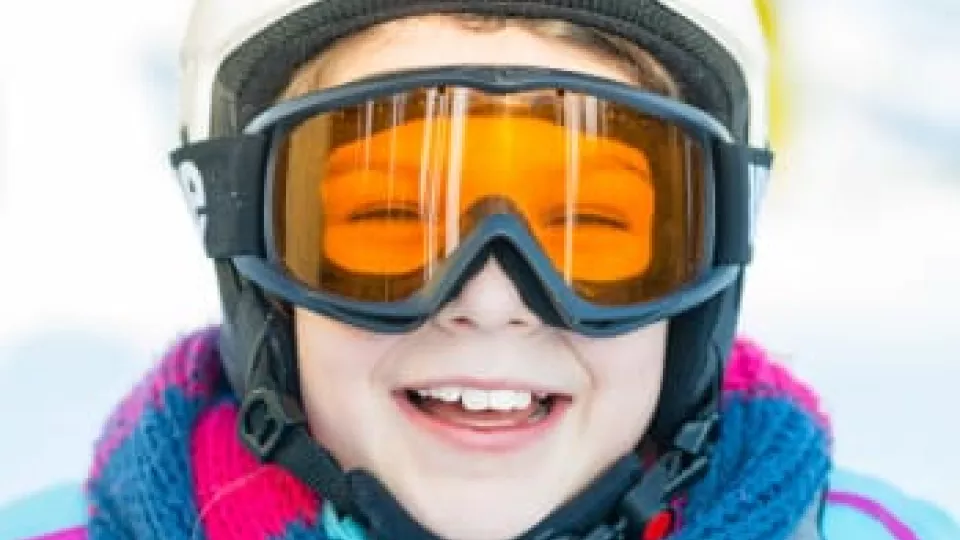
Winter Sports Eye Safety
Sports like skiing, snowboarding, snow tubing and sledding are on my boys’ wish list this year. I thought it would a good time to make sure that they are wearing protective eyewear with good polycarbonate lenses. Sunglasses are not just for lounging by the pool or on the golf course. The greatest danger to the eyes in the winter is ultraviolet light because snow is so blinding. So, proper eye protection is very important. Every year, hospital emergency rooms treat more than 40,000 sports-related eye injuries. More than one-third of those injured could be our children.
Before you hit the slopes, here are a few things to consider:
- The American Academy of Pediatrics says that children’s eyes are at increased risk for permanent damage from sunlight until they are at least 10 years old, because their eyes are highly sensitive and still developing. Furthermore, 90 percent of total lifetime damage from the sun’s harmful rays occurs by age 18.
- Skiers and snowboarders are often going at a good speed down the slopes, as well as coming relatively close to trees. Speed mixed with obstacles often result in injuries, such as twigs to the eye or a knock to the eyes by a ski pole while falling. Snow goggles also help skiers and snowboarders to see better since cold air and snow are not flying into their eyes and causing them to squint.
- A day on the ski slopes could be more damaging to your eyes than a day at the beach!
Why winter is rough on the eyes
UV rays can come from both above and below in wintery conditions. Snow reflects nearly 80 percent of the sun’s rays, while beach sand reflects only 15 percent. So when skiing or snowboarding, your UV exposure is nearly doubled. Higher elevations on ski slopes mean thinner air, which allows more ultraviolet radiation into the atmosphere. UV radiation goes up 3 percent for every 1,312 feet of altitude; so on top of some mountains exposure can increase over 15 percent. Overcast weather can be deceptive since visible light is reduced while UV light still gets through. This causes many to put away their sunglasses, leaving their eyes unprotected.
The risk of eye damage is highest in late winter and early spring, when days are getting longer. UV rays are strongest between 10 a.m. and 3 p.m., further south and at higher altitudes. During the winter months, humidity is lower and eyes can tend to dehydrate. Wind also dehydrates and irritates the eye. The thin clouds and haze of winter also do not absorb UV rays as well as thick, dark, heavy clouds ( http://www.sporteyes.com/sportseye.htm/)
Aside from simple discomfort, unprotected eyes are at serious risk of developing photokeratitis, or snow blindness. Photokeratitis is a painful problem caused by overexposure of the eyes to UV radiation, and can be thought of as a severe sunburn to sensitive ocular tissues. It’s often described as feeling like you have sand in your eyes and, painfulness aside, can also hamper your ability to perceive other risks while skiing. Exposure to cold may also cause eye pain, blurred vision and other vision problems.
Ways to protect your family’s eyes
- Purchase sunscreen that is made for just around the eyes. This will help to protect eyes from UV glares.
- Use eye drops. to guard against dry, irritated eyes.
- Look for goggles that have 100 percent UV protection, as well as polarized lenses. The UV protection keeps harmful UV rays from your eyes, while polarization absorbs glare from the snow surrounding you, helping you to see better.
- Tinted lenses work like sunglasses, while clear lenses are better for skiing or snowboarding at night. Among tinted lenses, you can choose typical brown or gray sun lenses; rose-colored lenses, which are helpful in overcast conditions (such as if you ski on a mountain that tends to be cloudy); or yellow lenses, which improve contrast in low light. You can even get photochromatic lenses, which change shades depending on light conditions.
- Some goggles also have magnetic or snap-in lenses that you can carry in your pocket and put on over the goggles’ built-in lenses if light conditions change.
- Sunglasses should be durable and guard against both UVA and UVB radiation.
- Wide-brimmed hats help protect eyes and the skin on your face.
Even with contact lenses that offer UV protection, sunglasses are still recommended. Clouds do not sufficiently shield our eyes from the sun, and all preventive measures should be taken on clear and cloudy days alike. Since snow and water surfaces reflect UV rays back into our eyes, we experience double exposure. Remember when doing winter or water sports, take extra precautions and use protective gear. It not only will make your trip more enjoyable but it can also help protect your eyes from damage.


